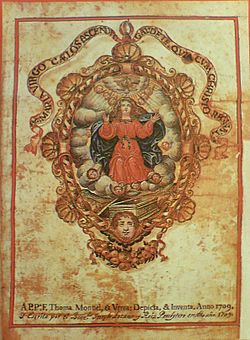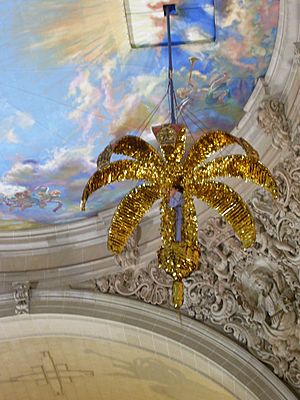Mystery Play of Elche facts for kids
Quick facts for kids Mystery play of Elche |
|
|---|---|

Front page of the 1709 Consueta, which is the script and music for the Misteri.
|
|
| Date(s) | 14 and 15 August |
| Frequency | Annual |
| Venue | Basilica de Santa María |
| Location(s) | Elche (Alicante), Spain |
| Mystery play of Elche | |
|---|---|
|
UNESCO Intangible Cultural Heritage
|
|
| Country | Spain |
| Domains | Performing arts, social practices, rituals and festive events |
| Reference | 18 |
| Region | Europe and North America |
| Inscription history | |
| Inscription | 2008 (3th session) |
| List | Representative |
The Mystery Play of Elche (called Misterio de Elche in Spanish and Misteri d'Elx in Catalan) is a very old play from the Middle Ages. It shows the story of the Blessed Virgin Mary (mother of Jesus). Specifically, it shows her Dormition (when she falls asleep and dies) and her Assumption (when she is taken up into Heaven).
This special play has two parts. It is performed every year on August 14 and 15. The show takes place inside the Basilica de Santa María in the city of Elche, Spain. In 2001, UNESCO recognized it as a "Masterpiece of the Oral and Intangible Heritage of Humanity." Later, in 2008, it was added to UNESCO's important list of cultural heritage.
Contents
History of the Play
There are two main ideas about when the Misteri d'Elx was first created.
Older Stories
One older story suggests the play started in the 13th century. A writer named Cristobal Sanz, in the early 1600s, said that people in Elche celebrated it in 1276. He also mentioned a story that after King James I took the city back from the Moors in 1265, the people decided to create this play.
In 1717, José Antón added to this old theory. He said that in May 1266, a mysterious box arrived on the beaches of Elche. Inside this box was a statue of the Virgin Mary and the Consueta. The Consueta is a document that contains the script and music for the play. This story helped explain why some people thought the play was so old. A composer named Óscar Esplá (1886–1976) also believed the 13th-century idea. He claimed to have seen a letter from 1266 that allowed the play to happen. However, this letter has never been seen since.
Modern Understanding
Since the late 1800s, historians have studied the play more closely. Most experts today agree that the play was likely written in the second half of the 15th century. This means it's still very old, but not as old as the 13th-century stories suggest.
The Stage and Special Effects
The play is performed inside the Basilica. The stage uses several special areas and devices to create the scenes.
The Heaven
A large linen cloth is placed high up, near the dome of the basilica. This cloth acts as the sky in the play. It also hides the machines that lift and lower actors and props. This "sky" is probably as old as the current version of the play. Old stage notes from the 1530s already mention it.
The linen cloth separates the heavenly scenes from the earthly ones. It has a square opening called the "Door to Heaven." This door opens and closes three times during the play. It allows the flying stage devices to come through.
The Pomegranate (La Magrana)
This is a flying device shaped like a pomegranate. It carries the first Angel who brings a golden palm branch to Mary. This palm branch shows her the way to Heaven. The device we see today was built in the second half of the 16th century. Its design is similar to other flying machines used in plays during that time.
For a while, people thought the name "pomegranate" was new. They thought the device used to be called a "cloud" and was blue, not red. But recent studies show that the name "pomegranate" was used as early as the 16th century. This might be because the current, stronger device replaced an older, more fragile one made of cotton and paper.
The Araceli
The Araceli is another flying device. It appears twice in the play. First, five angels use it to carry Mary's soul (which is a small statue) to Heaven. Four angels sing, while the main angel carries Mary's spirit. They appear to the Apostles, who then prepare to bury Mary's body.
The Araceli's second appearance is at the very end of the play. This time, the full image of Mary is carried up into the ceiling. As she rises, the Holy Trinity crowns her. The Araceli statue is similar to other sculptures made around the late 1400s and early 1500s.
The Platform (Cadafal)
This is a raised wooden platform where much of the play's action happens. It's roughly square and covers a hollow space underneath. Actors can change costumes or disappear into this hidden area. The platform is located under the dome and the "Heaven" cloth. It also extends into the choir area, connecting to the "Door to Heaven."
In Elche, the Cadafal is Mary's special area. It's where she experiences her journey to becoming holy and glorified. It's also the only place where characters from Heaven and people from Earth meet during the play. The word "cadafal" has always meant a raised stage or platform for dramatic action.
The Corridor
This is a long ramp built over the main aisle of the Basilica. It goes from the main door all the way to the Cadafal. There are two small seating areas on each side where the play's organizers and the priest sit.
The Corridor is very important symbolically. It turns the entire church into a stage for the play. More importantly, it represents the path that connects Earth and Heaven. It also shows the spiritual journey that everyone takes in life.
During the play, the actor playing Mary walks along this path. She goes from the church door to the Cadafal. This symbolizes her journey to unite with Christ.
The Music
The music for the play is found in a document called the Consueta. This name comes from two words meaning "custom" and "order." These manuscripts describe the ceremonies and include important notes on stage directions, musical scores, and how the stage devices work. The earliest Consueta dates back to 1625.
Performances
Regular Performances
- August 14: La Vesprà (The Vigil)
This is the first act. It happens on the evening before the Feast of the Assumption. It tells the story of Mary's final hours and her death. Her soul is taken to Heaven, leaving her body surrounded by the sad Apostles.
- August 15: La Festa (The Feast)
This is the second act. It begins at 10 AM with "El Soterrar" (The Interment). This part takes place outside the basilica. A procession carries the statue of the dead Virgin, along with the actors and bands playing songs from La Festa. The act then focuses on Mary's burial, her Assumption into Heaven, and her Coronation.
Preparations
Several events happen in the weeks leading up to the Misteri:
- August 6: La prova de veus (The test of voices)
This takes place in the Council Room. Singers are chosen for the play. This shows that the City Council of Elche, not the Church, helps pay for the play.
- August 10: La prova de l'àngel (The test of the angel)
This happens inside the basilica at 6 PM. Organizers test children to find those who don't get dizzy. These children are then chosen to ride the flying stage devices.
Special Performances
From August 11 to 13, there are "Assajos generals" or special performances. These are like dress rehearsals for the main show.
Criticism
Some parts of the play have received criticism. This is because of how certain characters are shown, which some people find unfair. For example, the way some Jewish characters are portrayed has been questioned. Critics suggest that the play's sponsors should consider updating these parts, similar to how other old plays have made changes to be more inclusive.
See also
 In Spanish: Misterio de Elche para niños
In Spanish: Misterio de Elche para niños
- Oberammergau Passion Play


